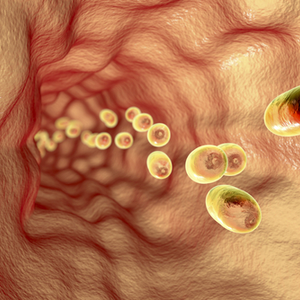
What is oesophageal cancer?
The oesophagus is a muscular tube that connects the throat and mouth with the stomach. Oesophageal cancer always affects the inner wall of the tube, the so-called oesophageal mucosa. This consists of flat cells (epithelial cells) that change as a result of tumour formation. Doctors distinguish between adenocarcinoma and squamous cell carcinoma of the oesophagus. Adenocarcinoma consists of the glandular cells of the mucous membrane and affects about four to five people out of every ten who suffer from oesophageal cancer. Squamous cell carcinoma, on the other hand, arises from the epithelial cells and affects between five to six people out of every ten who suffer from oesophageal cancer. Oesophageal cancer only manifests itself at a fairly advanced stage, for example through swallowing difficulties, which makes the disease a particularly treacherous cancer.
What promotes the development of oesophageal cancer?
Smoking, high alcohol consumption and frequent consumption of very hot drinks (65 °C or hotter) in particular favour the development of oesophageal cancer, as they can trigger so-called reflux disease. Acidic gastric juice enters the oesophagus and damages the mucous membrane. However, the consumption of nitrosamines, which are contained in numerous foods, also promotes the development of oesophageal cancer.
Chronic heartburn also contributes to changes in the mucous membrane cells at the lower end of the oesophagus in the long term. Similarly, obesity, tumours in the mouth and/or neck area, radiation in the neck and/or chest area or partial closure of the entrance to the stomach can increase the likelihood of developing oesophageal cancer. However, in many cases oesophageal cancer occurs even without these risk factors mentioned.
What are the symptoms of oesophageal cancer?
In most cases, oesophageal cancer only causes symptoms at an advanced stage. In particular, swallowing difficulties and frequent swallowing can indicate a narrowed oesophagus. However, swallowing difficulties are not uncommon, especially in older people. In addition, loss of appetite, weight loss as well as vomiting (also of blood) and blood in the stool (tarry stools) can also be symptoms of oesophageal cancer. If oesophageal cancer is suspected, a gastroenterologist should be consulted. He or she specialises in diseases of the digestive tract.
How is oesophageal cancer diagnosed?
Oesophageal cancer is a rare disease for which no screening is offered in Germany. However, people who have an increased risk of developing oesophageal cancer should consult their doctor to see if they should have a regular examination of the oesophagus and stomach.
For patients suspected of having oesophageal cancer, the doctor will first take a medical history. This is followed by a physical examination, in which the doctor checks whether the lymph nodes are enlarged or nodes can be felt. Since the oesophagus can only be examined from the outside to a limited extent, an endoscopy of the oesophagus is usually performed. If the suspicion is confirmed, further examinations are carried out to determine the stage of the tumour. These include an endoscopic ultrasound examination as well as a computer tomography or magnetic resonance imaging.
If the doctor suspects that the cancer has already spread to the larynx or bronchial tubes, a bronchoscopy or laryngoscopy will be performed. These examinations are similar to a gastroscopy.
What are the chances of recovery from oesophageal cancer?
As with other types of cancer, the chances of recovery from oesophageal cancer depend on the stage at which the tumour was diagnosed. Since oesophageal cancer is usually only discovered at an advanced stage, the tumour can only be surgically removed in about 40 percent of those affected. Despite improved treatment options, the five-year survival rate after an oesophageal cancer diagnosis is only between 15 and 20 percent.
How is oesophageal cancer treated?
The treatment of oesophageal cancer depends on the exact location of the tumour, but also on the spread of the cancer cells to other parts of the body. In addition, the patient's general state of health and other diseases must be taken into account.
For example, if it is a localised tumour growing in the mucous membrane of the oesophagus, endoscopic treatment is usually sufficient. In the case of an advanced tumour that has already grown deep into the mucous membrane, surgery is usually necessary. During this operation, part of the oesophagus is removed and, if necessary, chemotherapy or a combination of radiotherapy and chemotherapy is administered. If the cancer has already metastasised, chemotherapy, radiotherapy or medication can be given to prolong the patient's life and reduce pain. If a patient's oesophagus is already so narrowed by the tumour that it is no longer possible to eat, the doctor can also stretch the oesophagus (bougienage). This involves inserting a metal tube (stent) into the oesophagus to keep the path open for food.
Rehabilitation after cancer treatment
Many patients with oesophageal cancer need to continue to see their doctor regularly after successful treatment. This aftercare of the cancer treatment not only serves to detect a new tumour early enough, but also aims to support the patient with regard to a change in diet and can also offer psychological help if necessary. Those concerned can also make use of targeted rehabilitation, which also offers support in getting back into work and everyday life.
